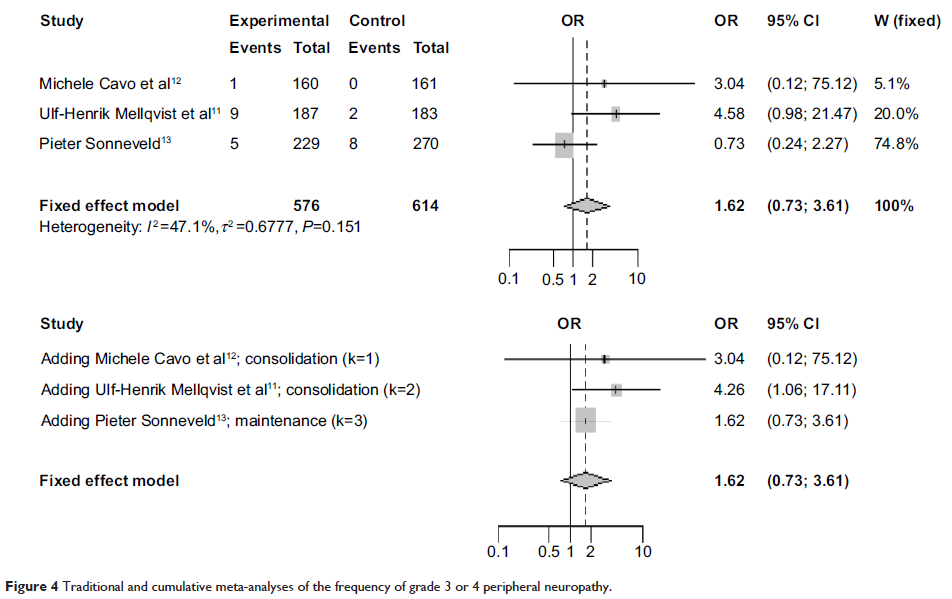9 7 6 4 1
论文已发表
注册即可获取德孚的最新动态
IF 收录期刊
- 3.3 Breast Cancer (Dove Med Press)
- 3.4 Clin Epidemiol
- 2.5 Cancer Manag Res
- 2.9 Infect Drug Resist
- 3.5 Clin Interv Aging
- 4.7 Drug Des Dev Ther
- 2.7 Int J Chronic Obstr
- 6.6 Int J Nanomed
- 2.5 Int J Women's Health
- 2.5 Neuropsych Dis Treat
- 2.7 OncoTargets Ther
- 2.0 Patient Prefer Adher
- 2.3 Ther Clin Risk Manag
- 2.5 J Pain Res
- 2.8 Diabet Metab Synd Ob
- 2.8 Psychol Res Behav Ma
- 3.0 Nat Sci Sleep
- 1.8 Pharmgenomics Pers Med
- 2.7 Risk Manag Healthc Policy
- 4.2 J Inflamm Res
- 2.1 Int J Gen Med
- 4.2 J Hepatocell Carcinoma
- 3.7 J Asthma Allergy
- 1.9 Clin Cosmet Investig Dermatol
- 2.7 J Multidiscip Healthc

已发表论文
硼替佐米 (Bortezomib) 为主与非硼替佐米为主的多发性骨髓瘤患者的移植后治疗:对 Ⅲ 期随机对照试验的系统性评价和综合分析
Authors Liu XP, He CK, Meng XY, He L, Li KL, Liang Q, Shao L, Liu SQ
Published Date June 2015 Volume 2015:8 Pages 1459—1469
DOI http://dx.doi.org/10.2147/OTT.S84828
Received 17 March 2015, Accepted 22 April 2015, Published 15 June 2015
Approved for publication by Professor Daniele Santini
Objective: To evaluate the efficacy and safety of bortezomib-based vs non-bortezomib-based post-transplantation therapy in patients with multiple myeloma.
Methods: Data of relevant randomized controlled trials assessing the effect of bortezomib as post-transplantation consolidation or maintenance therapy was obtained through a comprehensive search. The outcome measures included response rate, progression-free survival, overall survival, and adverse events (AEs). The hazard ratio (HR), Cochran-Mantel-Haenszel odds ratio (OR), and 95% confidence interval (95% CI) were applied to evaluate the effect of bortezomib in relation to the end points such as progression-free survival, overall survival, response rate, and AEs.
Results: Three randomized controlled trials comprising 1,518 participants were included in this study. Pooled ORs for the rates of overall response, and complete response and near complete response, were 1.85 and 1.75, respectively. Pooled HR for progression-free survival favored bortezomib-based therapy over non-bortezomib-based therapy (0.73, 95% CI: 0.67–0.81), while no statistically significant difference could be found between the two groups regarding the pooled HR for 3-year overall survival. Moreover, incidence rates of overall adverse events and grade 3 and 4 peripheral neuropathy were similar in the bortezomib-based groups and the non-bortezomib-based groups (P =0.12 and P =0.41, respectively). The corresponding cumulative meta-analyses of the rates of overall response rate, complete response and near complete response, and grades 3 and 4 peripheral neuropathy supported the superiority of bortezomib-based maintenance therapy over consolidation therapy.
Conclusion: Bortezomib-based therapy after autologous stem cell transplantation, with tolerable AEs, could obviously improve the response as well as the outcome of multiple myeloma patients, particularly when bortezomib was administered as maintenance therapy.
Keywords: multiple myeloma, post-transplantation therapy, bortezomib-based regimen
Methods: Data of relevant randomized controlled trials assessing the effect of bortezomib as post-transplantation consolidation or maintenance therapy was obtained through a comprehensive search. The outcome measures included response rate, progression-free survival, overall survival, and adverse events (AEs). The hazard ratio (HR), Cochran-Mantel-Haenszel odds ratio (OR), and 95% confidence interval (95% CI) were applied to evaluate the effect of bortezomib in relation to the end points such as progression-free survival, overall survival, response rate, and AEs.
Results: Three randomized controlled trials comprising 1,518 participants were included in this study. Pooled ORs for the rates of overall response, and complete response and near complete response, were 1.85 and 1.75, respectively. Pooled HR for progression-free survival favored bortezomib-based therapy over non-bortezomib-based therapy (0.73, 95% CI: 0.67–0.81), while no statistically significant difference could be found between the two groups regarding the pooled HR for 3-year overall survival. Moreover, incidence rates of overall adverse events and grade 3 and 4 peripheral neuropathy were similar in the bortezomib-based groups and the non-bortezomib-based groups (P =0.12 and P =0.41, respectively). The corresponding cumulative meta-analyses of the rates of overall response rate, complete response and near complete response, and grades 3 and 4 peripheral neuropathy supported the superiority of bortezomib-based maintenance therapy over consolidation therapy.
Conclusion: Bortezomib-based therapy after autologous stem cell transplantation, with tolerable AEs, could obviously improve the response as well as the outcome of multiple myeloma patients, particularly when bortezomib was administered as maintenance therapy.
Keywords: multiple myeloma, post-transplantation therapy, bortezomib-based regimen
